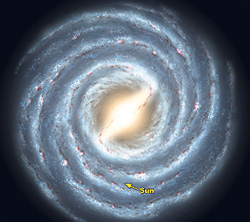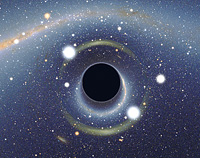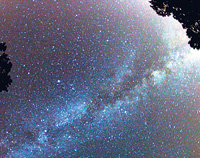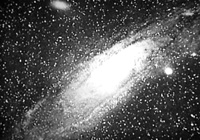Last month we took a peek at our universe and tried to comprehend its sheer vastness. Many things were discussed, one of which was the distance measuring unit known as a light year – the distance one single beam of light would travel in a year – a
whopping 10 trillion
kilometres.
We concluded with a promise to take a trip across our home galaxy the Milky Way in our next installment. Today we shall be doing just that. So,
buckle up and get those spacesuits on.
The Milky Way gets its name from the band of light that fills the night sky which, to the naked eye, looks like a milky, hazy stream, flowing smoothly along the heavens.
 |
| The Milky Way |
 |
| A simulated view of a black hole. |
 |
| The Milky Way as seen
from Earth. |
 |
| The Andromeda Galaxy |
Over the years it has come to be the official name of our galaxy, although some still refer to it as 'the Galaxy'. This galaxy is but one of billions of other galaxies, some
similar, some vastly
different, in our universe.
But it's unique. It is unique in that, unlike any other galaxy we have been able to observe so far, it remains the only one that is known to hold a solar system with a planet that can support life as we know it – our very own Planet Earth.
The Milky Way, at
13.2 billion years of age, is our home galaxy; it's where our Solar System resides,
forever orbiting its centre without a care in the, well, world. But ours is not the only system the Milky Way is home to. There are over 200 billion stars in our galaxy, roughly 40 times the world's population – that's 40 stars to every human being on Earth.
It has been suggested by astronomers (scientists who study space) that this figure could go well up to 400
billion if you took into account low-mass stars (stars with a very low mass), the exact number of which is uncertain at this point.
Let's stop and think about this for a moment – 200 to 400 billion balls of gas, many similar to our own Sun, fusing hydrogen into helium day in and day out, releasing massive amounts of life-giving
energy every passing
second. It has been proved beyond doubt that there are many star systems in our galaxy with planets orbiting them.
New 'extrasolar
planets', the name given to such planets outside our own solar system, are being
discovered almost everyday. Is it so impossible that at least one of these planets could support some kind of life form? Perhaps similar to our own, or maybe
completely different, or world's apart, so to speak?
And let's not forget that the Milky Way is but one galaxy; its neighbour Andromeda alone is home to one trillion stars. That's a lot of stars – possibly with a lot of planets going round them. What are the chances that at least one, just one, of these planets is home to
living, breathing creatures (or maybe even creatures that don't need to breathe in the first place)?
Getting back on topic, the Milky Way is what is known as a barred spiral galaxy.
It has four arms, or 'bars', extending from its core
(centre) which 'spiral' out into space. The galaxy's 'stellar disk', or the disk shaped area containing stars, is roughly 100,000 light years in diameter and is 1000 light years thick.
That's one huge disk, right? Smack in the middle of this disk is a tiny (in
astronomical terms, that is) and compact object with an extremely high mass
(or weight, to use a not-so- correct-but-easier-to-understand term). This object was recently confirmed to be a black hole, a term I'm sure you space buffs have heard countless times. And it's not just any black hole; it's a
super-massive black hole. Yes, sir!
What exactly is a black hole? Simply put, a black hole is a compact region in space from which nothing, can escape. This is because it has an unbelievably high gravitational field. Its
gravity is so high and so extreme that not even light, the fastest thing in the
universe, can leave its boundary, known as its 'event horizon'.
Scientists have found that in the
vicinity of a black hole, some very strange things can occur, like, for instance, the bending of spacetime itself. But I digress. We shall dwell on black holes and spacetime, and maybe even a bit of time-travel on another date.
Anyhow, now that we have arrived at the
extremely dense centre of our galaxy, you might
wonder just how far we have travelled. Home is a long way away from here, I'm afraid. Our solar system is somewhere between 26,000 to 35,000 light years from the Galactic Centre, depending on which
estimate you use. Whichever it is, you can rest assured that it's farther than anyone has ever travelled.
Where to now? Andromeda? The Eagle Nebula, home of the magical and awe inspiring Pillars of Creation? Or perhaps you would like to go see the Supernova that possibly gave us gold? The universe is a big place with endless
wonders to feast our senses on.
Till next time then… Happy stargazing! |





